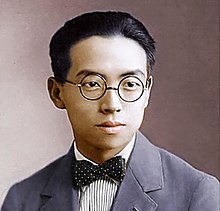Liang Sicheng
Liang Sicheng ( Chinese 梁思成 , Pinyin Liáng Sīchéng , W.-G. Liang Szŭ-ch'êng ; born April 20, 1901 , † January 9, 1972 ) was a Chinese architect, building and architecture historian, monument conservator and trainer. He tried very hard to maintain Chinese traditional buildings and to preserve them through monument protection and to enable their maintenance. He was an academician at Academia Sinica , a member of the Committee of Philosophy and Social Science Department of the Chinese Academy of Sciences . He is the son of Liang Qichao , the scholar and reformer from the end of the Chinese Empire.
He and his wife Lin Huiyin (Lin Whei-yin) collaborated in the scientific research of Chinese architecture.
life and work
In 1945, Liang was chairman of the architecture faculty at Tsinghua University . In 1946 he was visiting professor at Yale University , and he received an honorary doctorate from Princeton University . He was also nominated as representative of China for the advisory committee for the construction of the UN headquarters in New York . At that time he worked with Le Corbusier and other world-famous architects.
Liang Sicheng's ideas are still influential today. On the one hand, this applies to his research into Chinese building history and, on the other hand, to his reflections on the urban development concepts of megacities (which are now widespread worldwide). As early as 1949, Liang addressed the problem of generating traffic, especially commuter and supply traffic, which resulted from urban development concepts based on the resettlement of urban residents from the city center to the periphery. In particular, in the 1950s, together with Chen Zhanxiang and a few other experts, he turned against the idea of locating Beijing's administrative center in the old town near the Gate of Heavenly Peace .
Liang advocated the preservation of the historic old town and the city walls of Beijing and a new administrative center in the west of the old town. However, this idea of a polycentric structure in the Chinese capital did not prevail against the monocentric concept preferred by the Russian advisors and the Chinese political leadership.
During the Cultural Revolution , he was subjected to public humiliation, his home was ransacked, and he and his family were forced to move into a small room. In 2012, his house in one of the traditional hutong alleys in Beijing's downtown Dongcheng District was accidentally demolished. However, according to press reports, a reconstruction was planned.
Works
- Wilma Fairbank (ed.), Liang Ssu-ch'eng [Liang Sicheng]: A pictorial history of Chinese architecture . A study of the development of its structural system and the evolution of its types. (Original title: 《中國 建築 史》, 1954.) Cambridge: MIT Press, 1984; ISBN 0262121034 .
literature
- Wilma Fairbank: Liang and Lin . Partners in Exploring China's Architectural Past. Philadelphia: University of Pennsylvania Press, 1994 (with a foreword by Jonathan Spence ); ISBN 0812220404 (via Liang Sicheng and Lin Whei-yin ).
Individual evidence
- ↑ Notation in Fairbank 1994, passim.
- ↑ Jung Chang - Jon Halliday: Mao. The life of a man, the fate of a people. 5th edition, Munich 2005, p. 677
- ^ It's worth demolishing in FAZ of February 2, 2012, page 32
Web links
| personal data | |
|---|---|
| SURNAME | Liang Sicheng |
| ALTERNATIVE NAMES | Liang Ssu-ch'eng; Liang Szŭ-ch'êng |
| BRIEF DESCRIPTION | chinese architect |
| DATE OF BIRTH | April 20, 1901 |
| DATE OF DEATH | January 9, 1972 |
